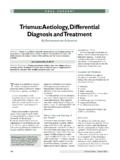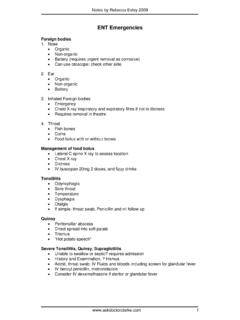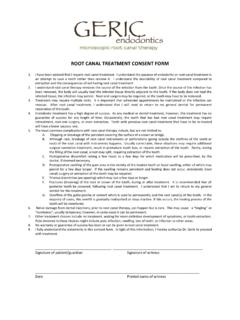Transcription of Current Tetanus treatment 22Jan - WHO
1 1 WHO/HSE/GAR/DCE/2010. 2 Current recommendations for treatment of Tetanus during humanitarian emergencies WHO Technical Note January 2010 WHO Communicable Diseases Working Group on Emergencies, Communicable Diseases Surveillance and Response, WHO Regional Office for the Americas 2 World Health Organization 2010 All rights reserved. The designations employed and the presentation of the material in this publication do not imply the expression of any opinion whatsoever on the part of the World Health Organization concerning the legal status of any country, territory, city or area or of its authorities, or concerning the delimitation of its frontiers or boundaries.
2 Dotted lines on maps represent approximate border lines for which there may not yet be full agreement. The mention of specific companies or of certain manufacturers products does not imply that they are endorsed or recommended by the World Health Organization in preference to others of a similar nature that are not mentioned. Errors and omissions excepted, the names of proprietary products are distinguished by initial capital letters. All reasonable precautions have been taken by the World Health Organization to verify the information contained in this publication.
3 However, the published material is being distributed without warranty of any kind, either express or implied. The responsibility for the interpretation and use of the material lies with the reader. In no event shall the World Health Organization be liable for damages arising from its use. For further information, please contact: Disease Control in Humanitarian Emergencies Department of Global Alert and Response World Health Organization 1211 Geneva 27 Switzerland Fax: (+41) 22 791 4285 3 Acknowledgements This technical note was compiled jointly by the unit on Disease Control in Humanitarian Emergencies (DCE), part of the Global Alert and Response Department (GAR) in the Health Security and Environment cluster (HSE), in collaboration with the Department of Immunizations, Vaccines and Biologicals (IVB) cluster at World Health Organization (WHO)
4 Headquarters, and supported by the Department of Communicable Disease Surveillance and Response, Expanded Programme on Immunization, and the Emergency and Humanitarian Action unit in the WHO Regional Office for the Americas. The technical note was developed by the Communicable Diseases Working Group on Emergencies (CD-WGE) at WHO headquarters. The CD-WGE provides technical and operational support on communicable disease issues to WHO regional and country offices, ministries of health, other United Nations agencies, and nongovernmental and international organizations.
5 The Working Group includes the departments of Global Alert and Response (GAR), Food Safety, Zoonoses and Foodborne Diseases (FOS), Public Health and Environment (PHE) in the Health Security and Environment (HSE) cluster; the Special Programme for Research and Training in Tropical Diseases (TDR); the Global Malaria Programme (GMP), Stop TB (STB), HIV/AIDS and Control of Neglected Tropical Diseases in the HTM cluster; Health Statistics and Informatics (HIS) in the Information, Evidence and Research (IER) Cluster; the departments of Child and Adolescent Health and Development (CAH), Making Pregnancy Safer (MPS), the department of Country Focus (CCO) in the Partnerships and UN Reform (PUN) cluster; Reproductive Health and Research (RHR), Immunizations, Vaccines and Biologicals (IVB) in the Family and Community Health (FCH) cluster.
6 Violence and Injuries Prevention (VIP) and Nutrition for Health and Development (NHD) and Chronic Diseases Prevention and Management (CHP) in the Noncommunicable Diseases and Mental Health (NMH) cluster; Clinical Procedures unit of Essential Health Technologies, (CPR/EHT) in HSS cluster, Health and Medical Services (HMS) and Security Services (SEC) in the General Management (GMG) cluster, and the cluster of Health Action in Crises (HAC) and the Polio Eradication Initiative (POL) and as a Special Programme in the Office of the Director General.
7 DCE gratefully acknowledges the Current and previous collaboration and input of the disease-specific focal points of the CD-WGE, the WHO Regional Office for the Americas and the Country Office of the WHO Representative for Haiti, which have made the production of this technical note possible. WHO would also like to thank the Government of Ireland (Irish Aid), the United States Agency for International Development (USAID), and the Office of Foreign Disaster Assistance (OFDA) of USAID for their continued support in the development of these documents.
8 4 Preface The purpose of this technical note is to provide health professionals in United Nations agencies, nongovernmental organizations, donor agencies and local authorities working with populations affected by emergencies with up-to-date technical guidance on the clinical management of Tetanus in emergency-affected populations, particularly following natural disasters. The clinical management of communicable diseases such as Tetanus represents a significant challenge to those providing health-care services in evolving situations.
9 It is hoped that this technical note will facilitate activities to control communicable diseases among agencies working with emergency-affected populations. Background Tetanus is an acute, toxin-mediated disease caused by Clostridium tetani. Under favourable anaerobic conditions, such as in dirty, necrotic wounds, this ubiquitous bacillus may produce tetanospasmin, an extremely potent neurotoxin. Tetanus toxin blocks inhibitory neurotransmitters in the central nervous system, resulting in muscular stiffness and spasms that are typical of Tetanus .
10 The disease can affect any age group and case-fatality rates are high (10-80%) even where modern intensive care is available. There is no natural immunity against Tetanus ; protection can be provided by active immunization with Tetanus toxoid-containing vaccine*, (TT: formalin-inactivated Tetanus toxin) or administration of an anti- Tetanus antibody ( Tetanus -specific immunoglobulin, TIG).1 Transmission and clinical characteristics Tetanus is not transmitted from person to person. Infection occurs when C.


















